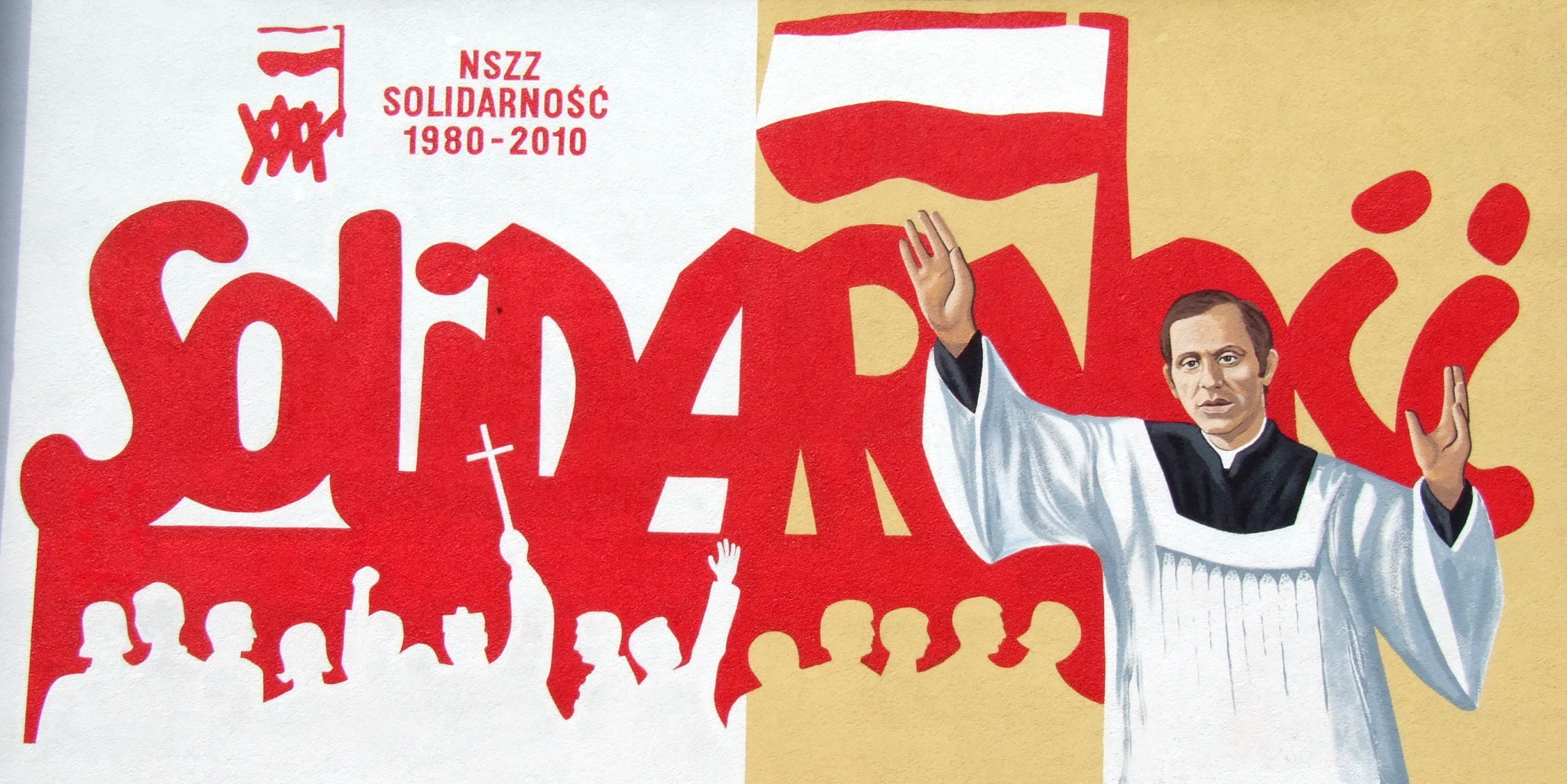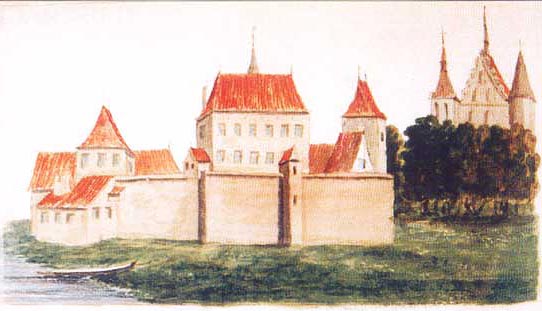|
Miserere (Górecki)
, Op. 44 () is a choral work composed in 1981 by Henryk Górecki for large (120 voices) a cappella mixed choir. The text comprises five words: '' (''Lord our God''), which are repeated for the first ten sections, resolved by a chorus of '' (''Have mercy on us'') in the eleventh and final section. Both lines of text are sung as imploring pleas. A typical performance lasts 35 minutes. Górecki composed the work in 1981 in protest to government intervention against the Polish Solidarity trade union - specifically, in response to the government-sanctioned assault of activists in Bydgoszcz. After martial law was enacted in December of that year, performance of the piece became impossible, and the piece was not performed until 1987. The first performance took place on 10 September 1987 in St. Stanisłaus Church Włocławek, and a day later in Bydgoszcz, with conducting the Bydgoszcz Philharmonic Choir. Background Henryk Górecki dedicated his Miserere to the city of Bydgoszcz. Bydgos ... [...More Info...] [...Related Items...] OR: [Wikipedia] [Google] [Baidu] |
Henryk Górecki
Henryk Mikołaj Górecki ( , ; 6 December 1933 – 12 November 2010) was a Polish composer of contemporary classical music. According to critic Alex Ross, no recent classical composer has had as much commercial success as Górecki. He became a leading figure of the Polish avant-garde during the post-Stalin cultural thaw. His Anton Webern-influenced serialist works of the 1950s and 1960s were characterized by adherence to dissonant modernism and influenced by Luigi Nono, Karlheinz Stockhausen,Thomas (1997), 17 Krzysztof Penderecki and Kazimierz Serocki. He continued in this direction throughout the 1960s, but by the mid-1970s had changed to a less complex sacred minimalist sound, exemplified by the transitional Symphony No. 2 and the Symphony No. 3 (''Symphony of Sorrowful Songs''). This later style developed through several other distinct phases, from such works as his 1979 ''Beatus Vir'',Cummings (2000), 241 to the 1981 choral hymn '' Miserere'', the 1993 ''Kleines Requiem f� ... [...More Info...] [...Related Items...] OR: [Wikipedia] [Google] [Baidu] |
A Cappella
''A cappella'' (, also , ; ) music is a performance by a singer or a singing group without instrumental accompaniment, or a piece intended to be performed in this way. The term ''a cappella'' was originally intended to differentiate between Renaissance polyphony and Baroque concertato musical styles. In the 19th century, a renewed interest in Renaissance polyphony, coupled with an ignorance of the fact that vocal parts were often doubled by instrumentalists, led to the term coming to mean unaccompanied vocal music. The term is also used, rarely, as a synonym for ''alla breve''. Early history A cappella could be as old as humanity itself. Research suggests that singing and vocables may have been what early humans used to communicate before the invention of language. The earliest piece of sheet music is thought to have originated from times as early as 2000 B.C. while the earliest that has survived in its entirety is from the first century A.D.: a piece from Greece called the ... [...More Info...] [...Related Items...] OR: [Wikipedia] [Google] [Baidu] |
Solidarity (Polish Trade Union)
Solidarity ( pl, „Solidarność”, ), full name Independent Self-Governing Trade Union "Solidarity" (, abbreviated ''NSZZ „Solidarność”'' ), is a Polish trade union founded in August 1980 at the Lenin Shipyard in Gdańsk, Poland. Subsequently, it was the first independent trade union in a Warsaw Pact country to be recognised by the state. The union's membership peaked at 10 million in September 1981, representing one-third of the country's working-age population. Solidarity's leader Lech Wałęsa was awarded the Nobel Peace Prize in 1983 and the union is widely recognised as having played a central role in the end of Communist rule in Poland. In the 1980s, Solidarity was a broad anti-authoritarian social movement, using methods of civil resistance to advance the causes of workers' rights and social change. Government attempts in the early 1980s to destroy the union through the imposition of martial law in Poland and the use of political repression failed. Operati ... [...More Info...] [...Related Items...] OR: [Wikipedia] [Google] [Baidu] |
Bydgoszcz
Bydgoszcz ( , , ; german: Bromberg) is a city in northern Poland, straddling the meeting of the River Vistula with its left-bank tributary, the Brda. With a city population of 339,053 as of December 2021 and an urban agglomeration with more than 470,000 inhabitants, Bydgoszcz is the eighth-largest city in Poland. It is the seat of Bydgoszcz County and the co-capital, with Toruń, of the Kuyavian-Pomeranian Voivodeship. The city is part of the Bydgoszcz–Toruń metropolitan area, which totals over 850,000 inhabitants. Bydgoszcz is the seat of Casimir the Great University, University of Technology and Life Sciences and a conservatory, as well as the Medical College of Nicolaus Copernicus University in Toruń. It also hosts the Pomeranian Philharmonic concert hall, the Opera Nova opera house, and Bydgoszcz Airport. Being between the Vistula and Oder (Odra in Polish) rivers, and by the Bydgoszcz Canal, the city is connected via the Noteć, Warta, Elbe and German canals with t ... [...More Info...] [...Related Items...] OR: [Wikipedia] [Google] [Baidu] |
Włocławek
Włocławek (Polish pronunciation: ; german: Leslau) is a city located in central Poland along the Vistula (Wisła) River and is bordered by the Gostynin-Włocławek Landscape Park. As of December 2021, the population of the city is 106,928. Located in the Kuyavian-Pomeranian Voivodeship, it was the capital of Włocławek Voivodeship until 1999. The city is located in the historical region of Kuyavia and is the region's third largest city after Bydgoszcz and Toruń. History Włocławek's history dates back to the late Bronze Age – early Iron Age (1300 BCE – 500 BCE). Archaeological excavations conducted on the current city site uncovered the remains of a settlement belonging to the Lusatian culture, as well as evidence of a settlement of early Pomeranian culture which had been established. Traces of additional settlements dating to the Roman period and the early Middle Ages have also been excavated in the area. Middle Ages Precise dating of the city's founding has proven ... [...More Info...] [...Related Items...] OR: [Wikipedia] [Google] [Baidu] |
Wojciech Jaruzelski
Wojciech Witold Jaruzelski (; 6 July 1923 – 25 May 2014) was a Polish military officer, politician and ''de facto'' leader of the Polish People's Republic from 1981 until 1989. He was the First Secretary of the Polish United Workers' Party between 1981 and 1989, making him the last leader of the Polish People's Republic. Jaruzelski served as Prime Minister from 1981 to 1985, the Chairman of the Council of State from 1985 to 1989 and briefly as President of Poland from 1989 to 1990, when the office of President was restored after 37 years. He was also the last commander-in-chief of the Polish People's Army, which in 1990 became the Polish Armed Forces. Born to Polish nobility in Kurów in eastern (then-central) Poland, Jaruzelski was deported with his family to Siberia by the NKVD after the invasion of Poland. Assigned to forced labour in the Siberian wilderness, he developed photokeratitis which forced him to wear protective sunglasses for the rest of his life. In 1943, Jaru ... [...More Info...] [...Related Items...] OR: [Wikipedia] [Google] [Baidu] |
Jerzy Popiełuszko
Jerzy Popiełuszko ( born Alfons Popiełuszko; 14 September 1947–19 October 1984) was a Polish Roman Catholic priest who became associated with the opposition Solidarity trade union in communist Poland. He was murdered in 1984 by three agents of (Security Service of the Ministry of Internal Affairs), who were shortly thereafter tried and convicted of the murder. He has been recognized as a martyr by the Catholic Church, and was beatified on 6 June 2010 by Archbishop Angelo Amato on behalf of Pope Benedict XVI. A miracle attributed to his intercession and required for his canonization is now under investigation. Biography Early life and priesthood Popiełuszko was born on 14 September 1947 in Okopy near Suchowola. After finishing school, he attended the priests' seminary at Warsaw. In 1966–1968, he served his army duties in a special force in Bartoszyce, aimed at keeping young men from becoming priests. This treatment had no effect on Popiełuszko's beliefs, as, after ... [...More Info...] [...Related Items...] OR: [Wikipedia] [Google] [Baidu] |
Symphony No
A symphony is an extended musical composition in Western classical music, most often for orchestra. Although the term has had many meanings from its origins in the ancient Greek era, by the late 18th century the word had taken on the meaning common today: a work usually consisting of multiple distinct sections or movements, often four, with the first movement in sonata form. Symphonies are almost always scored for an orchestra consisting of a string section (violin, viola, cello, and double bass), brass, woodwind, and percussion instruments which altogether number about 30 to 100 musicians. Symphonies are notated in a musical score, which contains all the instrument parts. Orchestral musicians play from parts which contain just the notated music for their own instrument. Some symphonies also contain vocal parts (e.g., Beethoven's Ninth Symphony). Etymology and origins The word ''symphony'' is derived from the Greek word (), meaning "agreement or concord of sound", "concert of ... [...More Info...] [...Related Items...] OR: [Wikipedia] [Google] [Baidu] |
Karol Szymanowski
Karol Maciej Szymanowski (; 6 October 188229 March 1937) was a Polish composer and pianist. He was a member of the modernist Young Poland movement that flourished in the late 19th and early 20th century. Szymanowski's early works show the influence of the late Romantic German school as well as the early works of Alexander Scriabin, as exemplified by his Étude Op. 4 No. 3 and his first two symphonies. Later, he developed an impressionistic and partially atonal style, represented by such works as the Third Symphony and his Violin Concerto No. 1. His third period was influenced by the folk music of the Polish Górale people, including the ballet ''Harnasie'', the Fourth Symphony, and his sets of Mazurkas for piano. ''King Roger,'' composed between 1918 and 1924, remains Szymanowski's most popular opera. His other significant works include ''Hagith'', Symphony No. 2, ''The Love Songs of Hafiz'', and '' Stabat Mater''. Szymanowski was awarded the highest national honors, in ... [...More Info...] [...Related Items...] OR: [Wikipedia] [Google] [Baidu] |
Aeolian Mode
The Aeolian mode is a musical mode or, in modern usage, a diatonic scale also called the natural minor scale. On the white piano keys, it is the scale that starts with A. Its ascending interval form consists of a ''key note, whole step, half step, whole step, whole step, half step, whole step, whole step.'' That means that, in A aeolian (or A minor), you would play A, move up a whole step (two piano keys) to B, move up a half step (one piano key) to C, then up a whole step to D, a whole step to E, a half step to F, a whole step to G, and a final whole step to a high A. : History The word ''Aeolian'', like the names for the other ancient Greek ''tonoi'' and ''harmoniai'', is an ethnic designation: in this case, for the inhabitants of Aeolis (Αἰολίς)—the Aeolian Islands and adjacent coastal district of Asia Minor. In the music theory of ancient Greece, it was an alternative name (used by some later writers, such as Cleonides) for what Aristoxenus called the Low Lydian '' ... [...More Info...] [...Related Items...] OR: [Wikipedia] [Google] [Baidu] |




.jpg)
